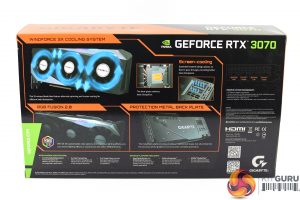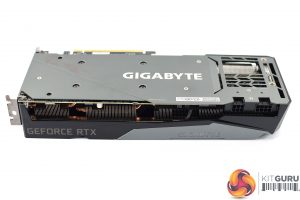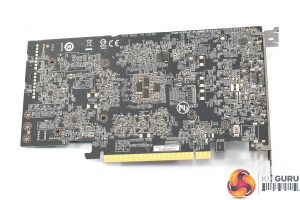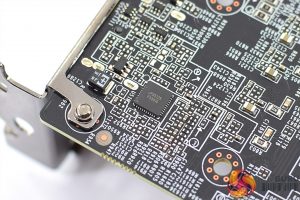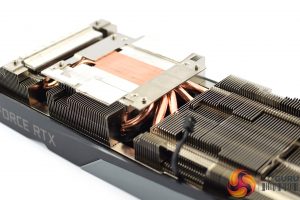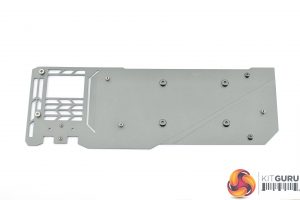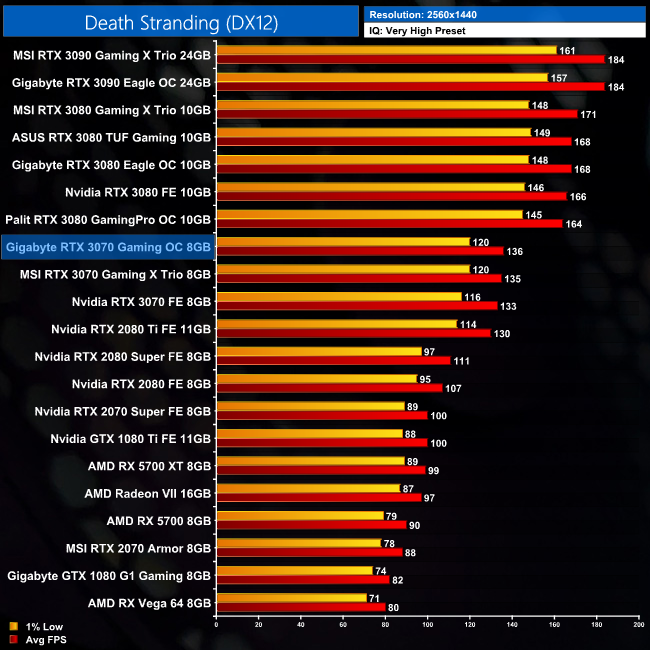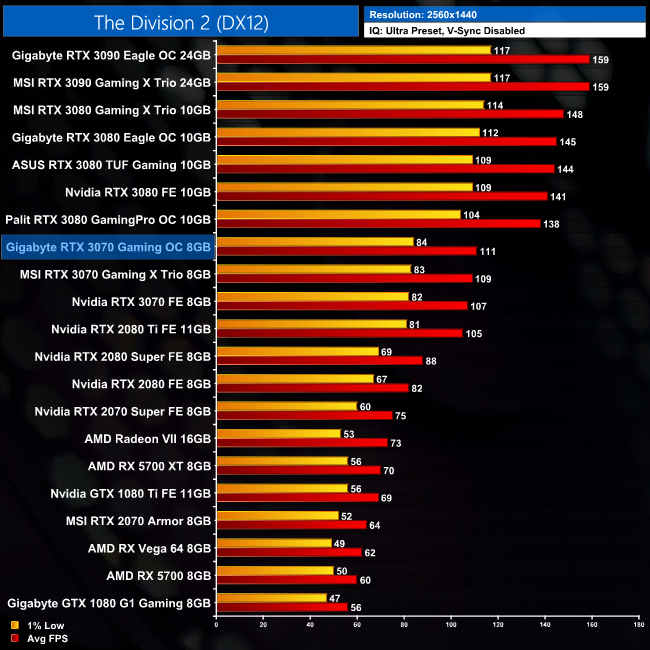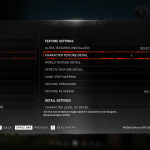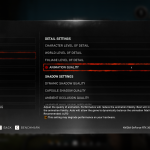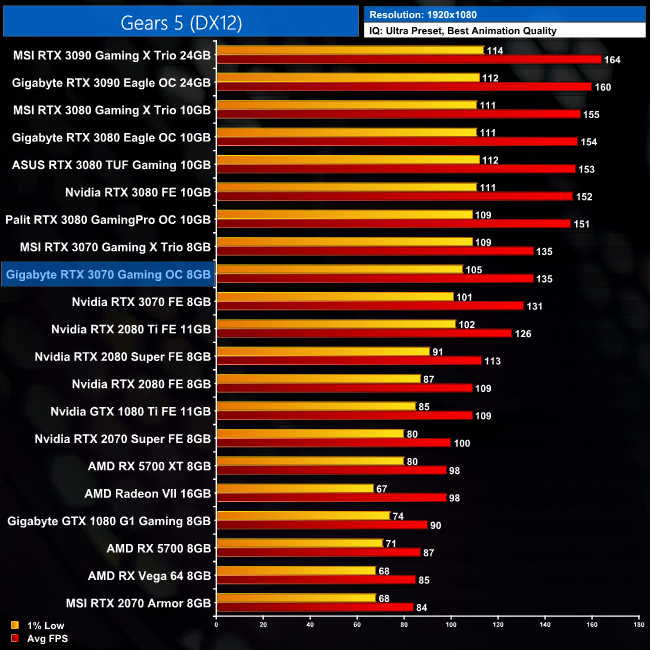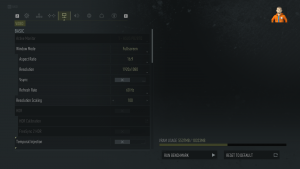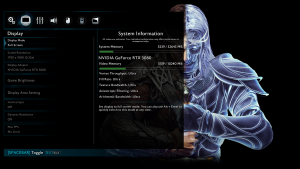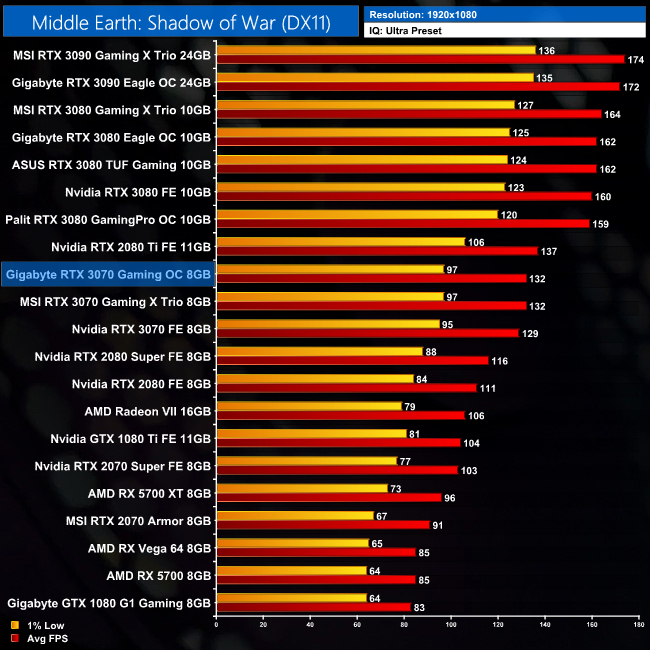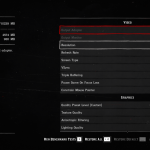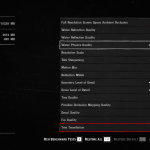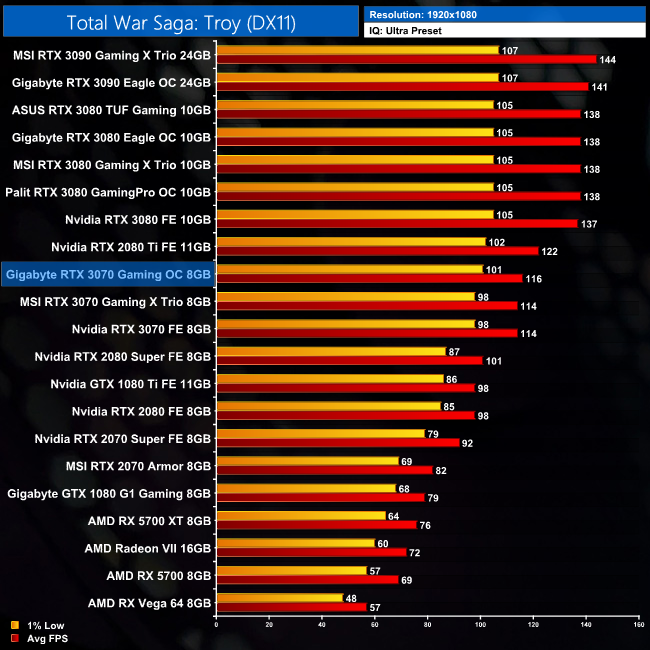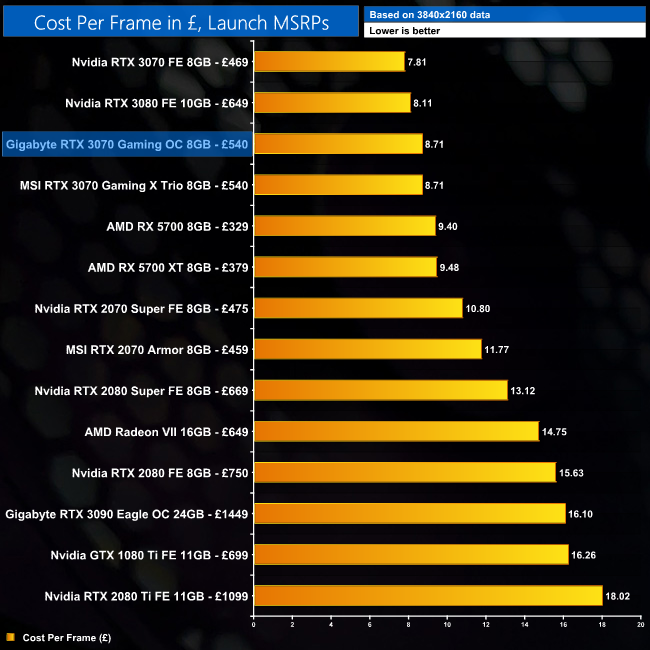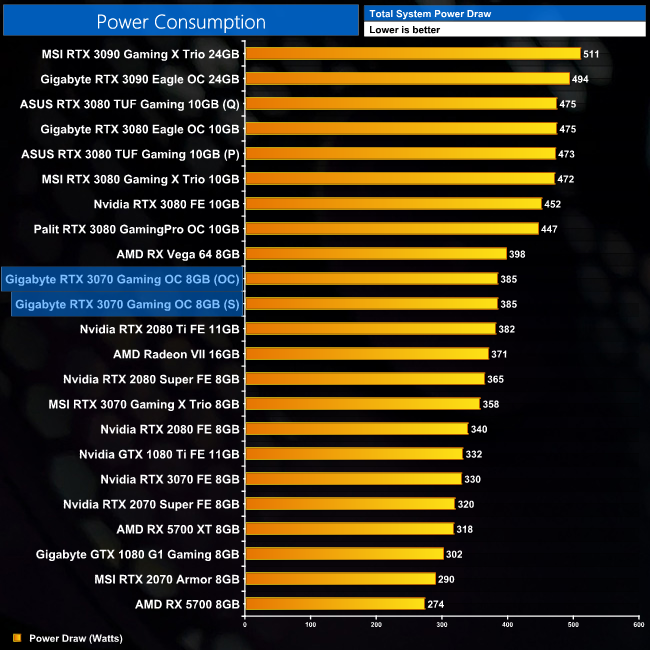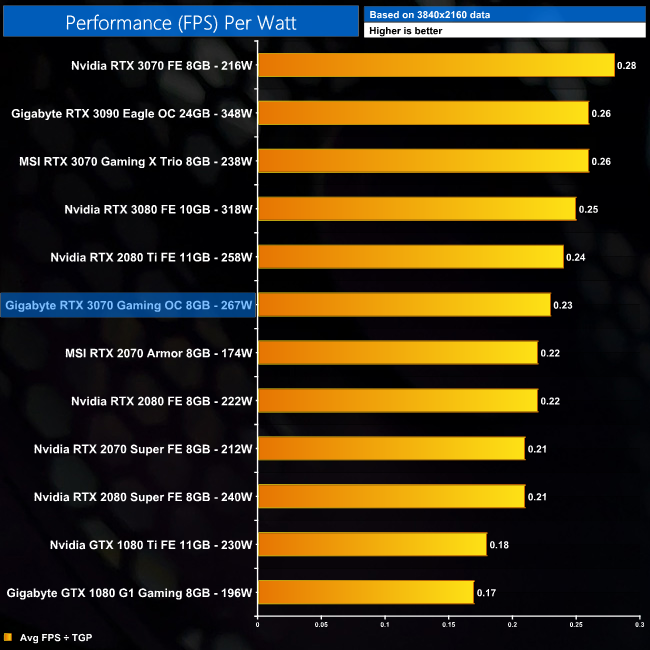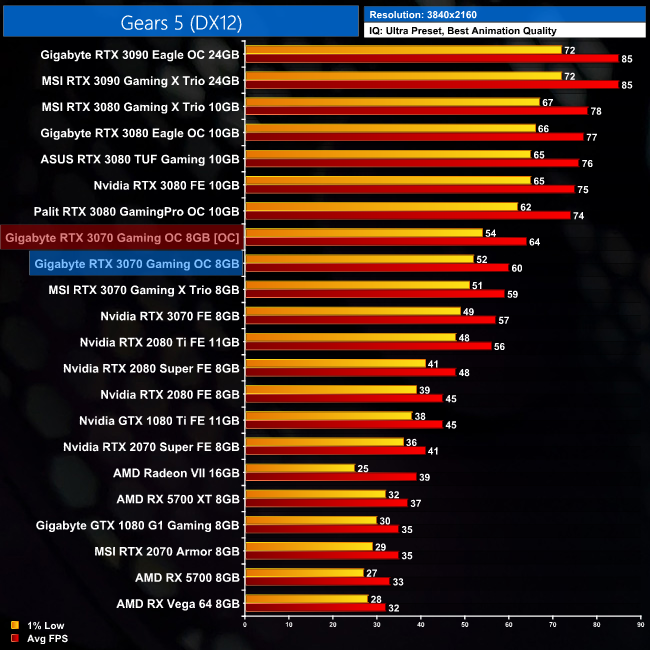
After reviewing Nvidia's RTX 3070 Founders Edition and MSI's RTX 3070 Gaming X Trio last week, today our attention turns to another custom model. The Gigabyte RTX 3070 Gaming OC sports a triple-fan cooler, dual-BIOS functionality and a power limit of 270W, which is an increase of 50W compared to the Founders Edition. But how much of a difference does that make to cooling, noise levels and overall gaming performance? We find out today.
With an MSRP of £539.99 here in the UK, the Gigabyte RTX 3070 Gaming OC is (meant to be!) identically priced to the MSI RTX 3070 Gaming X Trio, which could make a head-to-head comparison between the two very interesting indeed. Gigabyte's GPU may have a fractionally lower rated boost clock of 1815MHz, but its power limit of 270W is what will raise eyebrows – that is a 23% increased over reference, and is still 30W above even a custom card like the MSI Gaming X Trio.
Compared to both RTX 3070s we have reviewed so far, today we put the Gaming OC through its paces, testing it over 11 games while also analysing the thermal performance, noise levels and power draw of the graphics card.
| GPU | RTX 3090 | RTX 3080 | RTX 3070 | RTX 2080 Ti (FE) | RTX 2080 SUPER |
| SMs | 82 | 68 | 46 | 68 | 48 |
| CUDA Cores | 10496 | 8704 | 5888 | 4352 | 3072 |
| Tensor Cores | 328 | 272 | 184 | 544 | 384 |
| RT Cores | 82 | 68 | 46 | 68 | 48 |
| Texture Units | 328 | 272 | 184 | 272 | 192 |
| ROPs | 112 | 96 | 96 | 88 | 64 |
| GPU Boost Clock | 1695 MHz | 1710 MHz | 1725 MHz | 1635 MHz | 1815 MHz |
| Memory Data Rate | 19.5 Gbps | 19 Gbps | 14 Gbps | 14 Gbps | 15.5 Gbps |
| Total Video Memory | 24GB GDDR6X | 10GB GDDR6X | 8GB GDDR6 | 11GB GDDR6 | 8GB GDDR6 |
| Memory Interface | 384-bit | 320-bit | 256-bit | 352-bit | 256-bit |
| Memory Bandwidth | 936 GB/Sec | 760 GB/Sec | 448 GB/Sec | 616 GB/sec | 496.1 GB/sec |
| TGP | 350W | 320W | 220W | 260W | 250W |
To recap its core spec, unlike its more expensive RTX 30-series brethren, the RTX 3070 uses Nvidia’s GA104 GPU, instead of GA102. This implementation of GA104 incorporates 46 Streaming Multiprocessors (SMs), and thanks to Ampere’s new SM structure with its two FP32 datapaths, each SM houses 128 CUDA cores, giving RTX 3070 a total of 5888.
Ampere also places one RT core, and four Tensor cores, in each SM, giving a total of 46 RT cores and 184 Tensor cores. This is accompanied by 184 texture units, and 96 ROPs which are now housed directly within each graphics processing cluster (GPC), with 16 ROPs per GPC, and 6 GPCs in total for RTX 3070.
Clock speed is slightly higher than the RTX 3080. Where the RTX 3070 Founders Edition has a reference clock of 1725MHz, MSI has pushed this to 1830MHz boost. The power limit has also increased from 220W up to 240W.
Lastly, for the memory, RTX 3070 has ditched GDDR6X and we are back to 8GB of 14Gbps GDDR6 memory, operating over a 256-bit bus, for total memory bandwidth of 448 GB/Sec.
The Gigabyte RTX 3070 Gaming OC ships in a black box, with the company's large robotic eye logo taking pride of place on the front.
On the back, Gigabyte highlights some key features of the Gaming OC, including the WindForce 3X cooler, metal backplate and RGB lighting.
Two pieces of documentation are included; one that gives details on how to extend the product warranty to four years by registering the graphics card, while the other is a quick start guide.
Now, let's look at the graphics card itself. Gigabyte hasn't radically changed the design of its Gaming OC series since the last time we looked at a product from this family, with just a few more bits of grey on the shroud to break it up a little. It's overall a pretty understated look, and certainly compared to something like the MSI RTX 3070 Gaming X Trio, it is much less aggressive in its appearance.
For the cooler, Gigabyte is using its WindForce 3X design, obviously meaning it is a triple-fan configuration, with each fan measuring approximately 85mm. As we have come to expect, this cooler uses Gigabyte’s Alternate Spinning feature, where the central fan spins in reverse relative to the outer two, which should reduce turbulence and increase overall pressure down onto the heatsink itself. This is something we’ve now started seeing other manufacturers, like ASUS, do as well.
In terms of its size, it's not exactly a small graphics card, but it's not on the same level as the Gaming X Trio. With official dimensions of 286 x115 x 51 mm, it’s a 2-and-a-half slot card, but it is also quite short as it just fractionally taller than the PCIe bracket itself, which could appeal to those with particularly narrow cases.
Moving on to look at the backplate, this a full-length metal backplate, which is always something I am glad to see. It's a lovely shade of grey too, it almost looks silver depending on how the light hits it, and personally I think it looks great. The cut-out at the end of the backplate is designed to allow air to pass directly through the heatsink and out the back of the card.
We can also spy a dual-BIOS switch along the front side. By default the card uses the OC BIOS, but there is a Silent BIOS as well, and we test the differences between the two later on in this review.
Elsewhere, Gigabyte has opted for 1x 8-pin and 1x 6-pin power connectors, while display outputs consist of 2x DisplayPort 1.4a, and 2x HDMI 2.1.
Now then, let's look at the PCB. The GPU VRM is a 9-phase configuration, using AOZ5311NQI MOSFETs from Alpha and Omega, which are rated for 50A continuous output.
The GPU VRM is controlled by a UPI uP9512R (seen above, left) while the memory VRM is controlled by a UPI uS5650Q (above, right).
For the memory VRM, Gigabyte uses UPI Semi QN3106 and QN3102 N-Channel MOSFETs, with the QN3106 being deployed as two units per phase. This means that you get 2xQN3106 and 1xQN3102 N-Channel MOSFETs per memory VRM phase.
We can also note Gigabyte continues to use power extensions, meaning the 6 and 8-pin power connectors are not directly attached to the PCB, presumably to help with cable management.
In terms of the heatsink, this utilises three separate aluminium finstacks, which are connected by 5x 6mm copper heatpipes. These heatpipes make direct contact with the GPU die, while there’s an additional plate around the central mounting area which contacts with the Samsung GDDR6 memory via thermal pads.
The only slight disappointment is that the backplate doesn't contact with the back of the PCB. While this doesn't usually make a huge difference, I figure if you have the metal plate, you may as well use it to spread the heat out a little bit – just a few thermal pads on the back of the PCB would do the job.
Driver Notes
- All Nvidia GPUs (except RTX 3000) were benchmarked with the 452.06 driver.
- RTX 3070 was benchmarked with the 456.96 driver supplied to press.
- RTX 3080 was benchmarked with the 456.16 driver supplied to press.
- RTX 3090 was benchmarked with 456.38 public driver.
- All AMD GPUs were benchmarked with the Adrenalin 20.8.2 driver.
Test System
We test using the a custom built system from PCSpecialist, based on Intel’s latest Comet Lake-S platform. You can read more about it over HERE, and configure your own system from PCSpecialist HERE.
| CPU |
Intel Core i9-10900K
Overclocked to 5.1GHz on all cores |
| Motherboard |
ASUS ROG Maximus XII Hero Wi-Fi
|
| Memory |
Corsair Vengeance DDR4 3600MHz (4 X 8GB)
CL 18-22-22-42
|
| Graphics Card |
Varies
|
| System Drive |
500GB Samsung 970 Evo Plus M.2
|
| Games Drive | 2TB Samsung 860 QVO 2.5″ SSD |
| Chassis | Fractal Meshify S2 Blackout Tempered Glass |
| CPU Cooler |
Corsair H115i RGB Platinum Hydro Series
|
| Power Supply |
Corsair 1200W HX Series Modular 80 Plus Platinum
|
| Operating System |
Windows 10 2004
|
Comparison Graphics Cards List
- Gigabyte RTX 3090 Eagle OC 24GB
- MSI RTX 3090 Gaming X Trio 24GB
- ASUS TUF Gaming RTX 3080 OC 10GB
- Gigabyte RTX 3080 Eagle OC 10GB
- MSI RTX 3080 Gaming X Trio 10GB
- Palit RTX 3080 GamingPro OC 10GB
- Nvidia RTX 3080 FE 10GB
- MSI RTX 3070 Gaming X Trio 8GB
- Nvidia RTX 3070 FE 8GB
- Nvidia RTX 2080 Ti FE 11GB
- Nvidia RTX 2080 Super FE 8GB
- Nvidia RTX 2080 FE 8GB
- Nvidia RTX 2070 Super FE 8GB
- MSI RTX 2070 Armor 8GB
- Nvidia GTX 1080 Ti FE 11GB
- Gigabyte GTX 1080 G1 Gaming 8GB
- AMD Radeon VII 16GB
- AMD RX 5700 XT 8GB
- AMD RX 5700 8GB
- AMD RX Vega 64 8GB
Software and Games List
- 3DMark Fire Strike & Fire Strike Ultra (DX11 Synthetic)
- 3DMark Time Spy (DX12 Synthetic)
- 3DMark Port Royal (DXR Synthetic)
- Control (DX12)
- Death Stranding (DX12)
- The Division 2 (DX12)
- Far Cry New Dawn (DX11)
- Gears 5 (DX12)
- Ghost Recon: Breakpoint (Vulkan)
- Metro: Exodus (DX12)
- Middle Earth: Shadow of War (DX11)
- Red Dead Redemption 2 (Vulkan)
- Shadow of the Tomb Raider (DX12)
- Total War Saga: Troy (DX11)
We run each benchmark/game three times, and present mean averages in our graphs. We use OCAT to measure average frame rates as well as 1% low values across our three runs.
3DMark Fire Strike is a showcase DirectX 11 benchmark designed for today’s high-performance gaming PCs. It is our [FutureMark’s] most ambitious and technical benchmark ever, featuring real-time graphics rendered with detail and complexity far beyond what is found in other benchmarks and games today.
The RTX 3070 Gaming OC gets off to a strong start with our 3DMark benchmarks. It's 3% faster than Nvidia's Founders Edition in Fire Strike, and 5% faster in Timer Spy and Fire Strike Ultra.
3DMark Port Royal is the world’s first dedicated real-time ray tracing benchmark for gamers. You can use Port Royal to test and compare the real-time ray tracing performance of any graphics card that supports Microsoft DirectX Raytracing. As well as benchmarking performance, 3DMark Port Royal provides a realistic and practical example of what to expect from ray tracing in upcoming games.
In Port Royal, a hybrid rendered benchmark using rasterisation and ray tracing, the Gaming OC is 1% faster than the MSI RTX 3070 Gaming X Trio, and 4% faster than Nvidia's Founders Edition.
Control is an action-adventure video game developed by Remedy Entertainment and published by 505 Games. Control was released on 27 August 2019 for Microsoft Windows, PlayStation 4, and Xbox One. (Wikipedia).
Engine: Northlight Engine. We test using the High preset, with 4x MSAA, DX12 API.
Remedy's Control is the most demanding game in our test suite, with the Gaming OC averaging 79FPS at 1440p. At that resolution, it's 5% faster than Nvidia's Founders Edition.
Death Stranding is an action game developed by Kojima Productions. It is the first game from director Hideo Kojima and Kojima Productions after their split from Konami in 2015. It was released by Sony Interactive Entertainment for the PlayStation 4 in November 2019 and by 505 Games for Windows in July 2020. (Wikipedia).
Engine: Decima. We test using the Very High preset, with TAA, DX12 API.
In Death Stranding, the Gaming OC isn't massively faster than the other RTX 3070s in our chart. At 1440p for instance, it's just 2% faster than the Founders Edition, though this does increase to 4% at 4K.
Tom Clancy's The Division 2 is an online action role-playing video game developed by Massive Entertainment and published by Ubisoft. The sequel to Tom Clancy's The Division (2016), it is set in a near-future Washington, D.C. in the aftermath of a smallpox pandemic, and follows an agent of the Strategic Homeland Division as they try to rebuild the city. (Wikipedia).
Engine: Snowdrop. We test using the Ultra preset, but with V-Sync disabled, DX12 API.
In The Division 2, at 1440p Gigabyte's Gaming OC holds a 2% lead over the MSI Gaming X Trio, while this extends to 4% when compared to the Founders Edition.
Far Cry New Dawn is an action-adventure first-person shooter developed by Ubisoft Montreal and published by Ubisoft. The game is a spin-off of the Far Cry series and a narrative sequel to Far Cry 5. It was released for Microsoft Windows, PlayStation 4 and Xbox One on February 15, 2019. (Wikipedia).
Engine: Dunia 2. We test using the Ultra preset, with the HD Textures pack, DX11 API.
Far Cry New Dawn sees the Gaming OC scale better, relative to the Founders Edition at least, as the resolution increases. It is just 1% faster at 1080p, 2% faster at 1440p and then 4% faster at 4K.
Gears 5 is a third-person shooter video game developed by The Coalition and published by Xbox Game Studios for Xbox One, Microsoft Windows and Xbox Series X. It is the fifth installment of the Gears of War series and the sequel to Gears of War 4. The ultimate edition was released on September 6, 2019, while the standard edition of the game was released worldwide on September 10, 2019. (Wikipedia).
Engine: Unreal Engine 4. We test using the Ultra preset, with Best Animation Quality (instead of Auto), DX12 API.
Gears 5 sees decent performance gains for Gigabyte's Gaming OC – it is 5% faster than the Founders Edition at both 1440p and 4K, while it also holds a 2% advantage over MSI's Gaming X Trio at the same resolutions.
Tom Clancy's Ghost Recon Breakpoint is an online tactical shooter video game developed by Ubisoft Paris and published by Ubisoft. The game was released worldwide on 4 October 2019, for Microsoft Windows, PlayStation 4 and Xbox One, (Wikipedia).
Engine: AnvilNext 2.0. We test using the Very High preset, with AA disabled, Vulkan API.
Next up we come to Ghost Recon: Breakpoint. Here we see the Gaming OC is dead even with the Gaming X Trio at 1440p, as both hit 104FPS on average. Compared to the Founders Edition, this is a gain of 2%.
Metro Exodus is a first-person shooter video game developed by 4A Games and published by Deep Silver in 2019. It is the third instalment in the Metro video game series based on Dmitry Glukhovsky's novels, following the events of Metro 2033 and Metro: Last Light. (Wikipedia).
Engine: 4A Engine. We test using the Ultra preset, but with Hairworks and Advanced PhysX turned off, DX12 API.
In Metro Exodus, Gigabyte's RTX 3070 Gaming OC comes in 4% faster than Nvidia's Founders Edition, at both 1440p and 4K resolutions.
Middle-earth: Shadow of War is an action role-playing video game developed by Monolith Productions and published by Warner Bros. Interactive Entertainment. It is the sequel to 2014’s Middle-earth: Shadow of Mordor, and was released worldwide for Microsoft Windows, PlayStation 4, and Xbox One on October 10, 2017. (Wikipedia).
Engine: LithTech Firebird. We test using the Very High preset, DX11 API.
Middle Earth: Shadow of War is another game where the Gaming OC does better as the resolution is increased. Compared to the Founders Edition, is it 2% faster at 1080p, 3% faster at 1440p and then 5% faster at 4K.
Red Dead Redemption 2 is a 2018 action-adventure game developed and published by Rockstar Games. The game is the third entry in the Red Dead series and is a prequel to the 2010 game Red Dead Redemption. Red Dead Redemption 2 was released for the PlayStation 4 and Xbox One in October 2018, and for Microsoft Windows and Stadia in November 2019. (Wikipedia).
Engine: Rockstar Advance Game Engine (RAGE). We test by manually selecting High settings, not using a preset, including TAA, Vulkan API.
There's not a lot to split between all three RTX 3070s in Red Dead Redemption 2, and this is the only title where the Gaming OC is marginally slower than the Gaming X Trio. The difference is only a single frame at 1440p, though.
Shadow of the Tomb Raider is an action-adventure video game developed by Eidos Montréal in conjunction with Crystal Dynamics and published by Square Enix. It continues the narrative from the 2013 game Tomb Raider and its sequel Rise of the Tomb Raider, and is the twelfth mainline entry in the Tomb Raider series. The game released worldwide on 14 September 2018 for Microsoft Windows, PlayStation 4 and Xbox One. (Wikipedia).
Engine: Foundation Engine. We test using the Highest preset, with TAA, DX12 API.
The Gaming OC produces its best result in Shadow of the Tomb Raider, when gaming at 4K. At that resolution, it is 5% faster than the Founders Edition, and 2% faster than the Gaming X Trio.
Total War Saga: Troy is a 2020 turn-based strategy video game developed by Creative Assembly Sofia and published by Sega. The game was released for Windows on 13 August 2020 as the second installment in the Total War Saga subseries, succeeding Thrones of Britannia (2018). (Wikipedia).
Engine: TW 3 Engine. We test using the Ultra preset, DX11 API.
Finally we come to Total War Saga: Troy. This game is another tough one to run, and at 4K we see the Gaming OC hit an average frame rate of 46FPS. This is only 2FPS more than the Founders Edition, but that actually works out as a 5% difference here.
Here we present frame rate figures for each graphics card, averaged across all 11 games on test today. These figures can disguise significant variations in performance from game to game, but provide a useful overview of the sort of performance you can expect at each resolution tested.
On average, the Gaming OC is 3% faster than Nvidia's Founders Edition at 1440p, and 1% faster than the Gaming X Trio. At 4K, the average frame rate is on level pegging with the Gaming X Trio, so we're clearly not talking any major changes to overall performance.
Using the average frame rate data presented on the previous page, here we look at the cost per frame using the UK MSRP launch prices for each GPU.
With both the Gaming OC and Gaming X Trio offering 62FPS averaged across our 11 games at 4K, and both having the same £539.99 MSRP, cost per frame is identical at £8.71.
Here we present the average clock speed for each graphics card while running the 3DMark Time Spy stress test for 30 minutes. We use GPU-Z to record the GPU core frequency during the Time Spy runs. We calculate the average core frequency during the 30 minute run to present here.
Click to enlarge.
Clock speed behaviour for the Gigabyte RTX 3070 Gaming OC is incredibly consistent – it's probably the most stable frequency plot I have seen from any Ampere-based GPU so far, with speeds hovering at 1995MHz for the majority of our stress test.
We can also note how behaviour doesn't really change at all when switching from the OC BIOS to the Silent BIOS, as the frequency response is essentially identical between the two. The OC BIOS averaged 1999MHz across our stress test, with the Silent BIOS averaging 1995MHz.
For our temperature testing, we measure the peak GPU core temperature under load. A reading under load comes from running the 3DMark Time Spy stress test for 30 minutes.
Thermal performance is solid from the Gaming OC. With the OC BIOS, we saw a peak temperature of 68C and a steady state of 66C. Switching to the Silent BIOS adds 2C to both results, simply due to the fact the fans spin slower. Both BIOS run cooler than the Nvidia Founders Edition, but the Gaming X Trio is the coolest-running RTX 3070 we've tested so far.
We take our noise measurements with the sound meter positioned 1 foot from the graphics card. I measured the noise floor to be 32 dBA, thus anything above this level can be attributed to the graphics cards. The power supply is passive for the entire power output range we tested all graphics cards in, while all CPU and system fans were disabled. A reading under load comes from running the 3DMark Time Spy stress test for 30 minutes.
As for noise levels, this is really the only difference between both BIOS options. The Silent BIOS spins the fans at 1700rpm, compared to 1900rpm for the OC BIOS, and accordingly it is about 3dBa quieter based on our testing. It’s still not the quietest card we've tested, as the Silent BIOS itself comes in 3dBa louder than the MSI Gaming X Trio. It's certainly not loud however, and for the vast majority of users installing this in a case, it certainly wouldn't cause any problems.
We measure system-wide power draw from the wall while running the 3DMark Time Spy stress test for 30 minutes.
Total system power draw figures are identical between the two BIOS options. This is to be expected as both have the same 270W power limit.
We also use GPU-Z to measure Board Power (graphics card-only power draw). This is currently only available for Nvidia cards, which is why we have excluded AMD results from the chart. Aside from the fact this is software-based reporting, and not a hardware measurement of the PCIe power cables and PCIe slot (for that we’d need something like PCAT), this should provide us more accurate data to work with as it is measuring only the GPU power, and not total system power which is a fundamentally imprecise measurement.
For GPU-only power draw, both BIOS average 267W across our 30 minute stress test. This is a real-world increase of 51W compared to the Founders Edition, and 29W compared to the MSI Gaming X Trio.
By using the GPU-Z Board Power data in conjunction with the 11-game average FPS data we presented earlier in this review, we can work out performance per Watt for each graphics card. This is presented as FPS per Watt.
As a result of the significant increase to the power limit (+23% compared to reference), the Gaming OC is less efficient when compared to both the Founders Edition and the Gaming X Trio. The latter card offers 13% better performance per Watt.
For manual overclocking, as Gigabyte has already pushed the power limit to 270W, there is no scope to push it further in MSI Afterburner. However, we were still able to add 105MHz to the GPU core, and 1300MHz to the Samsung GDDR6 memory, bringing total speeds up to 16.6Gbps.
This overclock netted us gains of between 6-9% in the games we re-tested. These increases may not be as big as the Gaming X Trio, which improved between 9-11%, but the Gaming OC is coming from a higher starting point, so overall headroom is more limited.
With our third RTX 3070 review, today our attention has turned to Gigabyte and its RTX 3070 Gaming OC.
Gigabyte has pushed the power limit up 50W compared to reference spec, with the main benefit of that coming in the form of very stable out of the box clock speed behaviour. The GPU boosted to 1995MHz for the majority of our testing, and averaged 1999MHz across our 30 minute stress test. It's not quite 2GHz out of the box, but it may as well be.
This means the Gaming OC is the fastest RTX 3070 we've tested to-date. Once more, the differences aren't huge, but it is on average 3% faster than the Nvidia Founders Edition, and 1% faster than MSI's Gaming X Trio, when testing at 1440p. As I remarked in my Founders Edition review, I do feel RTX 3070 is best suited for 1440p high refresh-rate gaming, though it can do 4K – just not at an always-locked 60FPS in every single game.
Despite the 50W increase to power draw, Gigabyte's Gaming OC still runs relatively cool. With the OC BIOS engaged, we saw a peak temperature of 68C, and a peak of 70C when using the Silent BIOS, which runs the fans about 200RPM slower. That obviously means the Silent BIOS is the quieter of the two, though MSI's Gaming X Trio is quieter still in its out of the box state, while also offering slightly better thermal performance.
The main downside to this card is the reduction in power efficiency compared to both the RTX 3070 Founders Edition and the MSI Gaming X Trio. With graphics card-only power draw averaging 267W, that's almost a 24% increase compared to the Founders Edition, despite the Gigabyte GPU running no more than 5% faster in our testing. As a result, the Founders Edition offers noticeably better performance per Watt, to the tune of almost 22%.
We did manage to boost performance further via manual overclocking, with gains between 6-9% once our best overclock was dialled in. This may not be as big an increase to performance when compared to our overclocked Gaming X Trio, but that's simply because the Gaming OC comes from a higher starting point so its overall headroom is more limited.
All in all, the Gigabyte RTX 3070 Gaming OC is another very solid custom RTX 3070 card. I wouldn’t say it was clearly better than the MSI Gaming X Trio across the board, but I think that's because they are trying to do slightly different things. The Gigabyte Gaming OC runs faster out of the box, has a higher power limit and also comes with dual-BIOS, which I really like to see.
The Gaming X Trio, on the other hand, is the quieter card overall and it also runs a little bit cooler. With both supposed to cost £540 here in the UK – that’s the MSRP, at least – it really comes down to what features you personally prioritise the most. I myself would probably go for Gaming OC due to its dual-BIOS and higher power limit, but they’re both very attractive solutions.
AMD's RX 6000 is certainly going to provide the main competition to RTX 3070 when it launches later this month. AMD has shared plenty of its own performance numbers, but until I can test the cards myself, we won't know just how things stack up against the RTX 3070. If you are looking to buy a new graphics card though, I would certainly advising waiting for our RX 6000 reviews.
The Gaming OC has an MSRP of £539.99. It is currently up for pre-order on Overclockers UK for £589.99 HERE.
Discuss on our Facebook page HERE.
Pros
- Fastest RTX 3070 we've tested so far.
- Good looking, colour-neutral shroud.
- Very stable clock frequency.
- Dual-BIOS.
Cons
- Less efficient than the Founders Edition.
- Gaming X Trio is cooler and quieter out of the box.
- RX 6000 comes out this month.
KitGuru says: Gigabyte's RTX 3070 Gaming OC is a very capable RTX 3070 graphics card. We will know more about how it compares to AMD RX 6000 later this month.
 KitGuru KitGuru.net – Tech News | Hardware News | Hardware Reviews | IOS | Mobile | Gaming | Graphics Cards
KitGuru KitGuru.net – Tech News | Hardware News | Hardware Reviews | IOS | Mobile | Gaming | Graphics Cards





